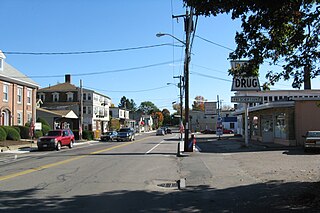
Attleboro is a commuter rail station on the MBTA's Providence/Stoughton Line located in Attleboro, Massachusetts. By a 2013 count, Attleboro had 1,665 daily riders, making it the sixth busiest station on the system.
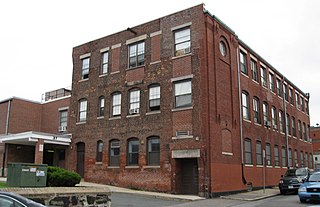
The Berger Factory is a historic factory building at 37 Williams Street in Boston, Massachusetts. Built in 1902, it was home to one of the nation's first manufacturers of precision engineering and surveying instruments, and a surviving example of Roxbury's late 19th-century industrial development. It was listed on the National Register of Historic Places in 1980, and now houses residences.

The North Attleborough Town Center Historic District encompasses the most historic elements of the central business district of North Attleborough, Massachusetts. The area was developed between about 1860 and 1830 as a center serving the community and the surrounding jewelry manufacturing businesses for which the town was well known. The district, extending along Washington Street between Fisher Street and Bruce Avenue, was added to the National Register of Historic Places in 1985.

The Wellington Piano Case Company Building is an historic building at 54 Green Street in Leominster, Massachusetts. The four story brick building was built in 1895 by Frank E. Wellington, who manufactured piano cases for upright and grand pianos. The building was listed on the National Register of Historic Places in 1984. It underwent conversion to residences in 2002.
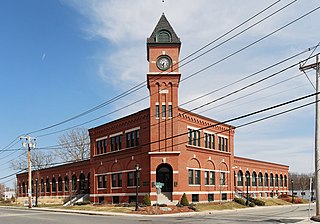
The H.F. Barrows Manufacturing Company Building, now the North Attleborough Police Station, is a historic industrial building at 102 South Washington Street in North Attleborough, Massachusetts. The elegant brick building was built in 1905-06, and was home for many years to one of the town's most successful jewelry businesses. It was listed on the National Register of Historic Places in 2001. Today the building serves as the headquarters for the North Attleborough Police Department.

Truesdale Hospital is a historic former hospital building located at 1820 Highland Avenue in Fall River, Massachusetts. It was built in 1920 and added to the National Register of Historic Places in 1986. It has since been converted into apartments, known as The Highlands.
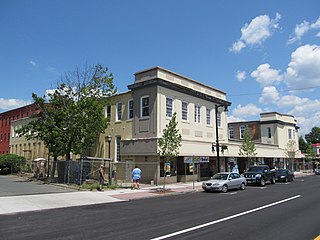
The United States Whip Company Complex or "United States Line Company Complex" is a historic factory located in Westfield, Massachusetts. It was owned and operated by one of the whip-making businesses that led Westfield to become widely known as "Whip City". United States Whip, created in 1892 by the consolidation of several local manufacturers, was the world's largest manufacturer of whips. The factory complex was listed individually on the National Register of Historic Places in 1983, and as part of an expanded Westfield Center Historic District in 2013.

James Addison Johnson was an American architect known for his design of various architectural landmarks in Buffalo, New York, and his use of decorative work that many consider a foreshadowing of art deco design.

The Commonwealth Avenue Historic District is a historic district on Commonwealth Avenue on the north side from Stanley Street to beyond Robinson Street in North Attleborough, Massachusetts. The area encompasses a variety of stylish 19th-century houses, as well as two 19th-century industrial buildings, depicting the proximity of wealthy industrial owners and managers to their factories. The district was added to the National Register of Historic Places in 2003.

The Wason-Springfield Steam Power Blocks are a collection of three historic commercial blocks at 27-43 Lyman St. and 26-50 Taylor Street in downtown Springfield, Massachusetts. They were built in the 1870s by the J.W. Wason Car Company and the Springfield Steam Power Company as facilities to support the development of new businesses in what was then called the North Blocks area of the city.
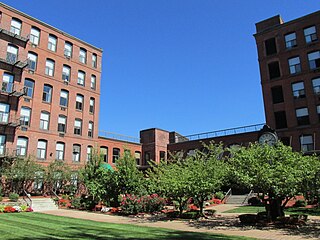
The Milton-Bradley Company is a historic former factory complex at Park, Cross, and Willow Streets in Springfield, Massachusetts. The factory was built beginning in about 1880, and expanded over the next decades to include a variety of brick multi-story buildings that are relatively utilitarian in appearance. When built, the property belonged to George Tapley, a principal in the Taylor and Tapley Manufacturing Company and a childhood friend of Milton Bradley. Bradley had entered the toy business in the 1860s, and moved his company to Tapley's premises in 1882. The success of his eponymous company led to a significant expansion of the premises, which eventually came to occupy an entire city block. The facilities were used in all aspects of toy and game manufacturing, including a lithographic print shop. The company moved its manufacturing to suburban East Longmeadow in the 1960s, and the complex was converted into residential housing in the late 1970s. It was listed on the National Register of Historic Places in 1983.

The State Normal Training School is a historic training school building at 27 Washington Street in Westfield, Massachusetts. It was constructed in 1899 to provide a teaching facility for teachers-in-training who were students at the Westfield State Normal School, the second-oldest such school the nation. It was operated jointly by the normal school and the city of Westfield from 1900 until 1956, at which point it was converted into a regular elementary school. The city formally acquired the property in 1977. It was listed on the National Register of Historic Places in 1983. The building now houses offices.
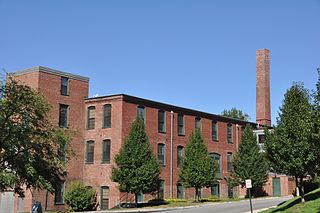
The Walker Body Company Factory is a historic factory complex on Oak Street at River Court in Amesbury, Massachusetts. It has been converted to residential use.

The Stoneham Railroad Depot is a historic train station at 36 Pine Street in Stoneham, Massachusetts. Built in 1895 by the Boston and Maine Railroad, it is one of two surviving train stations in the town, and the only one still at its original site. The building was listed on the National Register of Historic Places in 1984. It is now used for commercial purposes.

Lion Brothers Company Building is a historic factory located at 875 Hollins St, Baltimore, Maryland 21201. It is a multi-level building that once housed the operations of the Lion Brothers embroidery company. The original building was constructed in 1885 and expanded several times over the subsequent 75 years. In 1958 the Lion Brothers moved their production facility to another location allowing Marcus & Farber and Globe Screen Printing to move in. The building has been vacant since 2002 and Cross Street Partners has plans to restore the building as a local innovation center.

The Ashworth and Jones Factory is a historic building at 1511 Main Street in Worcester, Massachusetts. It is one of the architecturally finest mid 19th century factory buildings in the city. Built in 1870 and repeatedly enlarged, most of its sections retain high quality brickwork and mid-19th century Victorian styling. The factory was listed on the National Register of Historic Places in 1980. The complex has been converted into condominium residences known as Kettle Brook Lofts.

The Dennison Manufacturing Co. Paper Box Factory is a historic factory building at 175 Maple Street in Marlborough, Massachusetts.

The Strouse, Adler Company Corset Factory is a historic factory complex at 78-84 Olive Street in New Haven, Connecticut. Developed between 1876 and 1923, it was the largest and oldest of the city's several corset manufacturers, and remained in continuous operation for that purpose until 1998. The complex was listed on the National Register of Historic Places in 2002. It has since been converted into residential use.

The Kraus Corset Factory is a historic industrial property at 33 Roosevelt Drive in Derby, Connecticut. The oldest portion of the large brick, built 1879, faces Third Street, while a c. 1910 addition extends along Roosevelt Drive. It is the only major building to survive from Derby's period of corset manufacturing. It was built by Sidney Downs, one of Derby's leading businessmen of the period. The building was listed on the National Register of Historic Places on February 12, 1987. It has been converted into apartments.

C. R. Makepeace & Company, established in 1889, was a nationally active firm of mill architects based in Providence, Rhode Island. It was dissolved in 1944.






